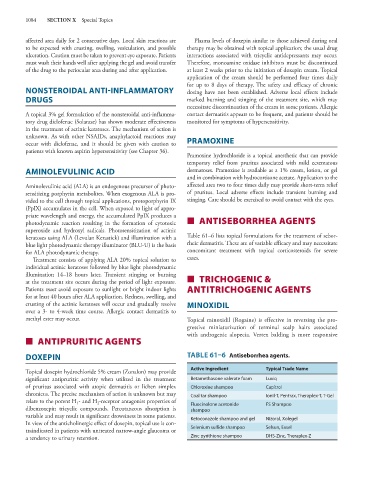Page 1098 - Basic _ Clinical Pharmacology ( PDFDrive )
P. 1098
1084 SECTION X Special Topics
affected area daily for 2 consecutive days. Local skin reactions are Plasma levels of doxepin similar to those achieved during oral
to be expected with crusting, swelling, vesiculation, and possible therapy may be obtained with topical application; the usual drug
ulceration. Caution must be taken to prevent eye exposure. Patients interactions associated with tricyclic antidepressants may occur.
must wash their hands well after applying the gel and avoid transfer Therefore, monoamine oxidase inhibitors must be discontinued
of the drug to the periocular area during and after application. at least 2 weeks prior to the initiation of doxepin cream. Topical
application of the cream should be performed four times daily
for up to 8 days of therapy. The safety and efficacy of chronic
NONSTEROIDAL ANTI-INFLAMMATORY dosing have not been established. Adverse local effects include
DRUGS marked burning and stinging of the treatment site, which may
necessitate discontinuation of the cream in some patients. Allergic
A topical 3% gel formulation of the nonsteroidal anti-inflamma- contact dermatitis appears to be frequent, and patients should be
tory drug diclofenac (Solaraze) has shown moderate effectiveness monitored for symptoms of hypersensitivity.
in the treatment of actinic keratoses. The mechanism of action is
unknown. As with other NSAIDs, anaphylactoid reactions may PRAMOXINE
occur with diclofenac, and it should be given with caution to
patients with known aspirin hypersensitivity (see Chapter 36).
Pramoxine hydrochloride is a topical anesthetic that can provide
temporary relief from pruritus associated with mild eczematous
AMINOLEVULINIC ACID dermatoses. Pramoxine is available as a 1% cream, lotion, or gel
and in combination with hydrocortisone acetate. Application to the
Aminolevulinic acid (ALA) is an endogenous precursor of photo- affected area two to four times daily may provide short-term relief
sensitizing porphyrin metabolites. When exogenous ALA is pro- of pruritus. Local adverse effects include transient burning and
vided to the cell through topical applications, protoporphyrin IX stinging. Care should be exercised to avoid contact with the eyes.
(PpIX) accumulates in the cell. When exposed to light of appro-
priate wavelength and energy, the accumulated PpIX produces a
photodynamic reaction resulting in the formation of cytotoxic ■ ANTISEBORRHEA AGENTS
superoxide and hydroxyl radicals. Photosensitization of actinic
keratoses using ALA (Levulan Kerastick) and illumination with a Table 61–6 lists topical formulations for the treatment of sebor-
blue light photodynamic therapy illuminator (BLU-U) is the basis rheic dermatitis. These are of variable efficacy and may necessitate
for ALA photodynamic therapy. concomitant treatment with topical corticosteroids for severe
Treatment consists of applying ALA 20% topical solution to cases.
individual actinic keratoses followed by blue light photodynamic
illumination 14–18 hours later. Transient stinging or burning
at the treatment site occurs during the period of light exposure. ■ TRICHOGENIC &
Patients must avoid exposure to sunlight or bright indoor lights ANTITRICHOGENIC AGENTS
for at least 40 hours after ALA application. Redness, swelling, and
crusting of the actinic keratoses will occur and gradually resolve MINOXIDIL
over a 3- to 4-week time course. Allergic contact dermatitis to
methyl ester may occur. Topical minoxidil (Rogaine) is effective in reversing the pro-
gressive miniaturization of terminal scalp hairs associated
with androgenic alopecia. Vertex balding is more responsive
■ ANTIPRURITIC AGENTS
DOXEPIN TABLE 61–6 Antiseborrhea agents.
Topical doxepin hydrochloride 5% cream (Zonalon) may provide Active Ingredient Typical Trade Name
significant antipruritic activity when utilized in the treatment Betamethasone valerate foam Luxiq
of pruritus associated with atopic dermatitis or lichen simplex Chloroxine shampoo Capitrol
chronicus. The precise mechanism of action is unknown but may Coal tar shampoo Ionil-T, Pentrax, Theraplex-T, T-Gel
relate to the potent H - and H -receptor antagonist properties of Fluocinolone acetonide FS Shampoo
1
2
dibenzoxepin tricyclic compounds. Percutaneous absorption is shampoo
variable and may result in significant drowsiness in some patients. Ketoconazole shampoo and gel Nizoral, Xolegel
In view of the anticholinergic effect of doxepin, topical use is con-
traindicated in patients with untreated narrow-angle glaucoma or Selenium sulfide shampoo Selsun, Exsel
a tendency to urinary retention. Zinc pyrithione shampoo DHS-Zinc, Theraplex-Z

